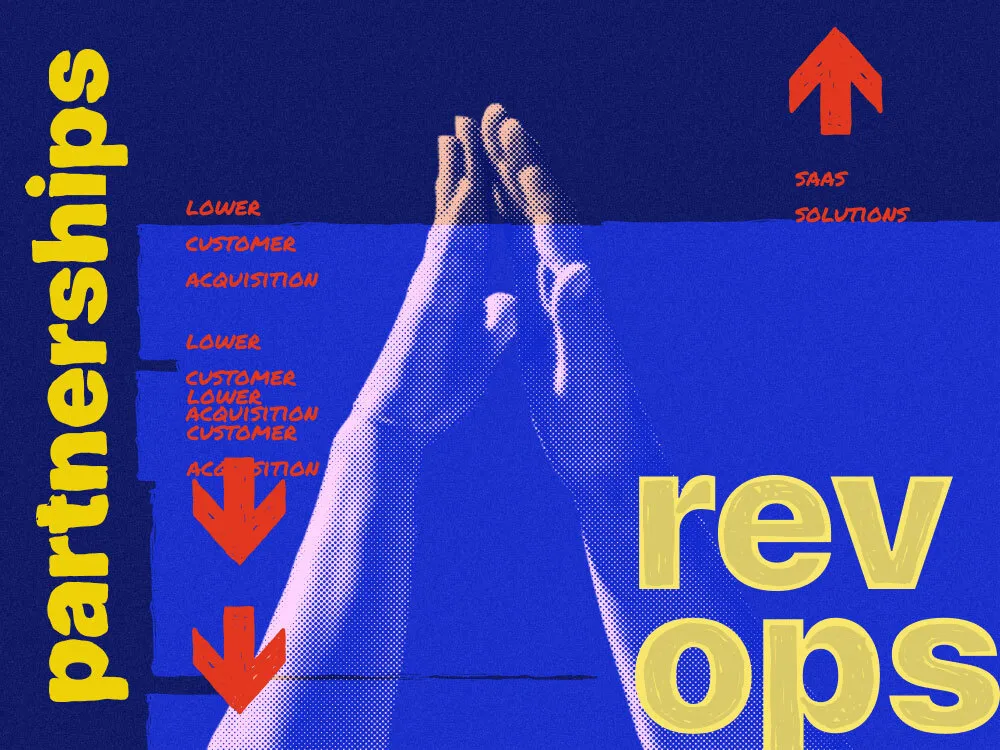Partnerships. Everyone is talking about this business strategy. It’s the panacea to all your go-to-market (GTM) ailments. With a growing number of businesses discovering that partnerships may be a cure-all for what ails us, the question is why isn’t everyone executing on it? The answer is simple: Very few individuals — and even fewer companies — are doing it well.
As a Chief Revenue Officer (CRO) of Carabiner Group, the world's first RevOps-as-a-Service℠ consultancy, I often hear from my peers that they are not able to articulate the value of partnerships to the board and the rest of their executive leader teams in a way that is easily quantifiable. At its core, many don’t understand it. Anecdotally, they know it pulls on many levers. Many have heard that going through partners can lower customer acquisition cost (CAC), help drive sales velocity, and make SaaS solutions stickier. But how do you drive that function forward when many don’t know how to align their goals to helping the rest of the company — who to hire for the role, and most critically, how to put the rigor of process around it to make it work?
Related: Here’s how partnerships can fit into your organization.
The challenge is clear. How do you operationalize partnerships?
CRO advice: How to make partnerships actually work at your company
To start, as an industry, we need to stop hiring that one person who is great at making friends, throwing them some basic slides and tossing them into the ether to see what they come back with. The sink or swim approach to staffing and training is unsustainable and is the fastest way to lose. The Partner-Led motion takes just as much thought and care as a typical Sales-Led, Product-Led or inbound motions. It has to come from the top — starting with a clear vision from leadership, with the right strategy, resourcing and information cascading down for partnership professionals to execute against.
When talking to partnerships leaders, the need to operationalize strategically becomes clear. Zak Pines, the VP of Partnerships at Formstack, has a strong grasp on how to set partnerships as a function up right.
“Partnership leaders need to look both inwards and outwards. Internally, ask the question, ‘How can partnerships help every single function in your business?’; get alignment on how — and make it happen,” says Pines, who goes on to share his playbook further. “Outwardly, partner-facing — figure out what type of company will make a great partner for you — and then work tirelessly to win over those partners and build and deliver joint value to customers.”
The process involves tracking the work and having a strong ability to speak to the impact. “Measure both hard results and soft results along the way, communicate your wins big and small, and keep earning support from your leadership team,” adds Pine.
In the early days, don’t be afraid to experiment. There are a lot of ways to drive channel, some examples include:
- Your clients
- Communities
- Independent software partners (ISV)
- Resellers
Understand what drives your partners, communities and buyers to be engaged on your behalf. Find out what drives them intrinsically — what motivates them and exactly what they need. How can you add value and impact to their world? Find out, deliver and track the progress. Be scientific: this is a time for testing and it's okay to fail. Not everything will work and you’ll learn from the mistakes you make. Your goal is to collect the data to show the effects of your efforts.

For us at Carabiner, we tracked all lead sources by doing something simple, asking on every intro call. How did you hear about us? How did the person who told you hear about us? Two simple questions uncovered a spider web of dark social influence that we were able to track back to strategic investments we had made.
We started a regular operating cadence with our partners just like you would with internal cross-functional teams. Like many, we started with simple account overlaps using tools like Crossbeam to uncover low-hanging fruit. We spun up co-branded collateral and learned how to find new use cases for our partners’ products. We looked into markets that were overlooked and hadn’t heard of these tools before. We showed up in community, engaging in meaningful, empathetic ways, always adding value to the people with whom we interacted.
Related: How to improve customer reviews to scale your partnerships revenue.
Scaling, engaging and growing partner-sourced revenue
Simple processes like these in the early days allowed us to see where and what was working, and thus we doubled down on the places where we were most effective. Adjusting your opportunity costs away from the areas where it's not working is just as, if not more, important.
Scaling can look a little different depending on the company and their approach. At Pavillion, word of mouth referrals are a big part of the fabric within their ecosystem, according to Aaron Leeder, the VP Partnerships at Pavilion. “Revenue leaders rely on trust and personal connections,” says Leeder. “There’s a sense of reliability and credibility for the software or services being recommended in the halls of our community.”
The channel partnerships they engage in, on the other hand, involve formal agreements for them to collaborate in promoting their partners’ products or services. “Over the years we’ve helped companies gain traction through joint marketing efforts. Those that have performed the best through our channel, came first with a point of view of giving their expertise to the community,” says Leeder. “It’s tempting to begin searching for what they could extract from Pavilion, but by looking first only where they could add value, they’d built a favorability around their brand. This motion directly correlated to an increase in the word of mouth referrals."
"The authentic recommendations from trusted leaders are worth their weight in gold."
-Aaron Leeder, Pavillion
Partnerships scaling tactics: Year one to three — and how we did it
Once we had the data from those early results we kept iterating. We built two motions based on data:
- Community-Led (for us, this is all channel and ISV)
- Word-of-mouth/Referral
With 53 per cent of our year one revenue coming from these two we knew we had something to build on.
At Carabiner, we operationalized it around community engagement and in-person events. Year two saw a staggering jump to 91.5 per cent as we doubled down on the strategy. I’ve been hearing the same things anecdotally from dozens of CROs/CMOs this year that it's the thing driving the most pipe and closed-won business today.
In year three, we moved from process to amplifying with technology and a heavier focus on highlighting our partners. We use a tool called Fluincy, to help “listen” to our client calls. We set up automated notifications for when we should be introducing software partners to our clients based on the use cases they are calling out. Pair that with partner directories and you’re taking out a lot of the guess-work in directly sending your partners referrals from slack — all at the push of a button.
Jessie Shipman, CEO and founder of Fluincy, understands the value of big picture thinking and excellent timing. “Partner awareness is the first major hurdle in partner enablement. It’s impossible for your teams to know about every possible partner solution when it’s relevant to their customer,” explains Shipman. “If they can’t remember what partner solution solves which customer problem, having a one-pager sitting in a PRM isn’t going to solve this. The right partner at the right time and why is the only thing that can.”
Focusing on those things has led to more bidirectional partner sourced revenue than we had ever produced before.
Partnerships is a long game with revenue as the win — if you play it right
Partnerships are a long game and need the time and space to mature. It can feel like an uphill battle at larger orgs. Just ask Dan O’Leary, Director of Partnerships at Box .
"Building partnerships, especially those informed by Nearbound GTM tactics, reminds me of the 'This is fine' meme,” says O’Leary.
As a partnerships leader, he has weathered many conditions and markets for this work over time. “It can start off looking chaotic, like the dog sitting in a burning room. But unlike that dog, leaders in the C-suite don't — can't sit back,” O’Leary continues, “They use the chaos as a chance to create something great for their customers by working with partners. Nearbound strategies help us connect with similar markets and customers, turning a fiery start into forged, strong partnerships. It's about making the best out of a tricky situation and ending up with a winning team where partners are a part of your team working to make customers super successful."

Because the partnerships game is long, the start of a program may look very different from a well-oiled and smooth-running ecosystem. But the saying is true: pressure makes diamonds, and so it is in the world of partnerships.
Final words from our featured CRO
New partnership tech can alleviate a lot of the manual burden we’ve typically dealt with in channel sales to meet common goals for RevOps. Imagine a way to help you track and execute peer-to-peer executive alignment on your late stage opportunities with referrals from your network. Or what if you had a tool that could identify the perfect client referral based on company size and use case, all without having to navigate the internal knowledge gate-keepers?
As these pieces come to the fore, companies are going to continue building out the function. It is a necessary motion as we move forward and seek to drive down costs and increase access to deeper relationships with our buyers. The future is smart work through indirect channels and ecosystem-led growth.

















